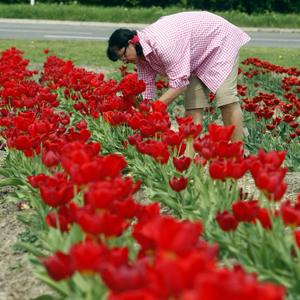
This is the VOA Special English Agriculture Report.
Bulbs are underground plant stems. They provide food for a shoot. Some bulbs produce flowers year after year. Gardening experts say tulips, daffodils and other bulbs are not very difficult to grow.
Bulbs do well in climates with a cold season. They are placed in the ground about the time of the first frost. But, with the right preparation, they can also grow well in places where the ground never freezes.
Mike Lizotte of American Meadows, an online store, says before you start, you need know whether to plant tender bulbs or hardy bulbs. If you live in a cold area, a tender bulb will need special care when the growing season is over.
MIKE LIZOTTE: "If you want that bulb to survive or come back, you would need to literally dig it out of the ground and bring it inside to a warm area because it just -- it will not survive, or it would get killed by the cold temperatures."
But Mike Lizotte says a hardy bulb can stay in the ground all year.
MIKE LIZOTTE: "A hardy bulb is one that prefers cold temperatures. So therefore it can be left in the ground, such as a daffodil or tulip."
Sandra Mason from the University of Illinois Extension service has some suggestions to get a good start on planting bulbs. First, the most important thing is to choose a place with soil that drains well.
SANDRA MASON: "How wet the soil is, that ends up being a big issue. For certain areas, if you have a lot of clay in your soil, you may find that bulbs do not last a long time for you, as in just a couple years. Or you may find they just do not do very well at all, and they actually rot in the soil."
Sandra Mason suggests planting most big bulbs like tulips or daffodils about 15 to 20 centimeters deep. Smaller bulbs can be planted about seven to ten centimeters deep. She says she enjoys planting smaller ones like snowdrop bulbs.
SANDRA MASON: "I love planting those because you do not need to dig a very deep hole. We like those!"
Bulbs should be planted with their pointed end up, toward the surface. But some bulbs do not seem to have a pointy end. In that case, Ms. Mason says, look for an "eye" that might have a stem. But don't worry if you cannot find one.
SANDRA MASON: "The good news is, the bulbs will figure it out."
Do not use fertilizer for the first year. After that, if you do fertilize the bulbs, do not mix the fertilizer in the planting hole. It could burn the roots.
There is a trick people can use to grow bulbs in places where the ground never freezes. Keep the bulbs cold in a refrigerator for about three months, then take them out and let them get used to the warmth. Now the bulbs will be ready to develop normally, colorful blooms and all.
And that's the VOA Special English Agriculture Report, written by Jerilyn Watson. Share your gardening stories and get more advice at voaspecialenglish.com. We're also on the VOA Learning English page on Facebook. I'm Bob Doughty.
Home gardening: What to do about lead
America, how does your garden grow?
Art of darkness: growing vegetables in shade
In the garden: growing your own lettuce
(來源:VOA 編輯:崔旭燕)
